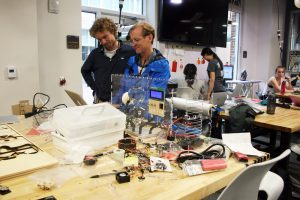Celebrating 20 Years of Teaching at UNC: Q&A with Professor Rich Goldberg
 Applied Physical Sciences professor Richard Goldberg is celebrating his 20th year at UNC! Dr. Goldberg has brought tremendous teaching experience and background in undergraduate curriculum design to the Applied Physical Sciences department and is currently leading efforts to build our minor and undergraduate major in applied sciences and engineering. We spoke to him to learn about his journey from graduate school to APS Teaching Associate Professor .
Applied Physical Sciences professor Richard Goldberg is celebrating his 20th year at UNC! Dr. Goldberg has brought tremendous teaching experience and background in undergraduate curriculum design to the Applied Physical Sciences department and is currently leading efforts to build our minor and undergraduate major in applied sciences and engineering. We spoke to him to learn about his journey from graduate school to APS Teaching Associate Professor .
Q: What brought you to UNC?
I had just completed graduate school at Duke, where I studied medical ultrasound imaging, and had an opportunity to look at bat echolocation as a postdoc in a UNC lab. This was closely enough related to my graduate research, but it was also an interesting opportunity because I was able to work with 50 flying bats in Taylor Hall on campus. It was a pretty unique experience to get to do that.
Q: Were you interested in pursuing research after graduate school, or were you always interested in teaching?
When I was in graduate school, all of the students were required to TA for three semesters. I was a TA for a biomedical instrumentation class and I loved it. It was always a lot of work, but teaching the class ended up being a highlight of my time as a graduate student. I had no idea going into graduate school that I wanted to teach, and I was surprised by how much I enjoyed teaching.
I accepted the postdoc position at UNC after graduation to pursue a research track, and during my postdoc, I became familiar with faculty members in the biomedical engineering (BME) department. They encouraged me to begin teaching a capstone design class in the BME department where students learned to develop assistive technologies for people with disabilities. I taught this class for 20 years in BME, and for more than 10 of those years, I taught it jointly at UNC and Duke with a colleague.

Q: You were also instrumental in starting the undergrad program in BME?
The capstone design class I taught evolved into a faculty position where I helped start the undergraduate program in BME at UNC. This program
launched in 2000 and was part of the Curriculum in Applied Sciences and Engineering, which is the predecessor to the Applied Physical Sciences department.
Q: How do you approach teaching now compared to when you began your career?
Teaching 20 years ago was so different because there was no PowerPoint. It was expected that you lectured in front of a chalkboard. When I was in grad school, I attended a lecture by Richard Felder at NC State, who was a pioneer of faculty training in active learning techniques. That was my first exposure to this idea that lecture style teaching doesn’t work for everybody. The seed was planted in my mind that there are different ways of teaching – it doesn’t all have to be standing up at the board. I continue to feel like I’m constantly learning new ways to reach diverse groups of students.
Q: Do you have any advice for students who may be considering a teaching career like yours?
Become involved in organizations where you can interact with people from around the country and learn about what’s going on in your field. Listen and interact with your students. Interacting with students is the most gratifying part of my job. Lastly, be open to suggestions from students and peers. Nobody’s perfect at any job, and you can learn a lot from talking to your students and be willing to learn from them.
Q: What excites you about what lies ahead for the Applied Physical Sciences department?
We have such an incredible opportunity to develop a program from scratch. As the discipline continues to grow, we are able to learn from some of the best practices employed across the country and use that as a guide for creating a really unique program that builds on and takes advantage of the best of UNC.

